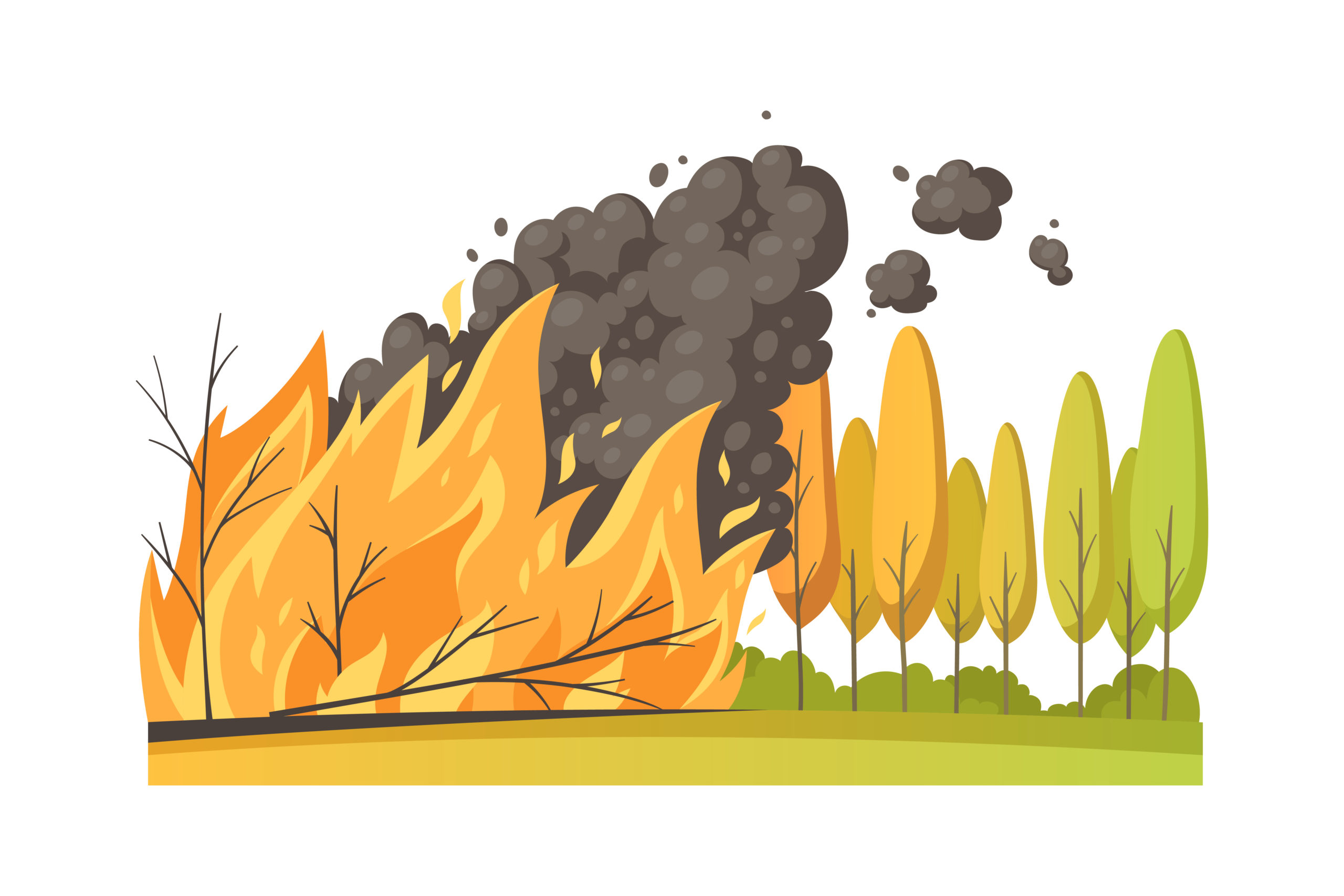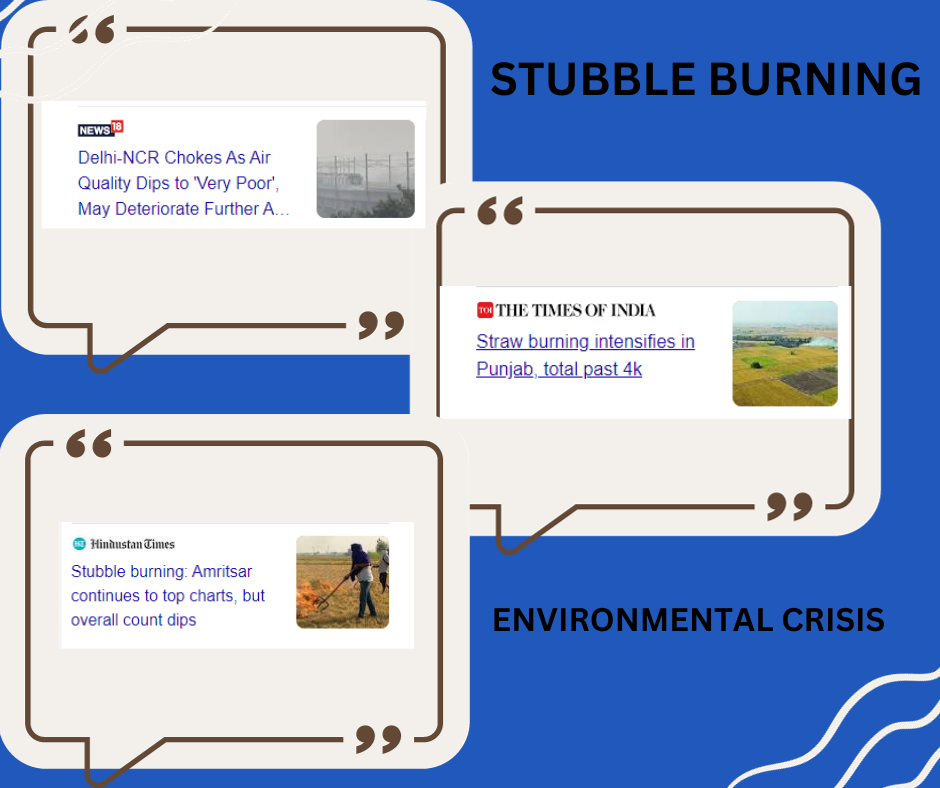Contact: +91 99725 24322 |
Menu
Menu
Quick summary: Unveiling the Threat: Stubble Burning as an Environmental Problem - Discover the far-reaching consequences of this age-old agricultural practice and explore sustainable alternatives for a greener future

Stubble burning, a common agricultural practice in many parts of the world, has drawn increasing attention due to its severe environmental consequences. This practice involves setting ablaze the leftover crop residue, or stubble, in fields after harvest. While it may seem like a quick solution to prepare fields for the next planting season, stubble burning releases harmful pollutants, contributes to air pollution, and exacerbates the global issue of climate change.
Down to Earth, estimates that crop residue burning released 149.24 million tonnes of carbon dioxide (CO2), over 9 million tonnes of carbon monoxide (CO), 0.25 million tonnes of oxides of sulphur (SOX), 1.28 million tonnes of particulate matter and 0.07 million tonnes of black carbon.
In this blog, we will delve into the environmental repercussions of stubble burning, its impact on air quality, soil health, and offer insights into alternative, sustainable practices that can help mitigate these concerns.
Burning stubble is a common practice in agricultural areas when crops residues are left in fields after harvest. It is used to quickly clear fields in preparation for the following planting season.
Stubble burning is common in many agricultural areas around the world, especially in nations with extensive crop growing. In areas of India, China, North America, and Europe, where mechanized farming and the requirement for prompt field preparation for the following crop cycle promote its adoption, it is a widespread practice.
Stubble burning is often resorted to by farmers for several practical reasons:
Addressing stubble burning’s environmental consequences requires an understanding of these complex factors. Sustainable solutions involve providing farmers with viable alternatives that consider time constraints, traditional beliefs, and economic realities while promoting practices that are environmentally responsible and contribute to long-term agricultural sustainability.

Stubble burning significantly contributes to air pollution, releasing a cocktail of harmful pollutants. This includes particulate matter (PM), carbon monoxide (CO), nitrogen oxides (NOx), and volatile organic compounds (VOCs). These pollutants have serious consequences for human health. Prolonged exposure to air pollution from stubble burning can cause or exacerbate conditions like asthma, bronchitis, and other respiratory diseases, posing a severe threat to human health, particularly in regions with extensive burning.
Stubble burning releases significant amounts of greenhouse gases (GHGs), primarily carbon dioxide (CO2) and methane (CH4). While CO2 is a long-lived GHG, CH4 is far more potent in terms of its heat-trapping abilities. Methane emissions result from incomplete combustion during the burning process and from the degradation of organic matter in the soil due to increased temperatures caused by burning. The net effect is an increase in GHGs, contributing to global climate change and exacerbating issues related to rising temperatures and more frequent extreme weather events.
The intense heat generated during stubble burning alters the physical, chemical, and biological properties of the soil. The high temperatures reduce soil microbial activity and destroy organic matter. This has a detrimental impact on soil fertility, as organic matter plays a critical role in nutrient retention and availability for plants. Over time, the repeated practice of stubble burning can lead to reduced soil productivity, necessitating greater reliance on synthetic fertilizers to maintain crop yields, further contributing to environmental issues.
Stubble burning can have a negative impact on local biodiversity. The fires can destroy habitats for various wildlife species, such as insects, birds, and small mammals, which may rely on crop residues for shelter or food. The loss of these habitats can disrupt local ecosystems, affecting the balance of predator-prey relationships and leading to a decline in biodiversity. Additionally, the pollutants released from stubble burning can have direct and indirect harmful effects on wildlife and aquatic ecosystems, impacting their health and viability.
Addressing the environmental toll of stubble burning requires a shift toward more sustainable agricultural practices that mitigate these consequences. Alternative methods, such as mulching, incorporation of crop residues, and no-till farming, can help preserve soil health, reduce emissions, and protect both human health and local ecosystems.
Government Interventions
Burning Bans: Some governments have implemented strict bans on stubble burning during specific periods, often coinciding with the harvest season. Violating these bans can result in penalties or legal consequences.
Awareness Campaigns: Governments, along with non-governmental organizations, conduct awareness campaigns to educate farmers about the environmental and health consequences of stubble burning. These campaigns aim to encourage behavior change.
Subsidies for Machinery: In some cases, governments provide subsidies to farmers to invest in machinery like crop residue balers, mulchers, and ploughs that facilitate the management of crop residues without burning.
Financial Assistance: Financial incentives are often offered to farmers who adopt sustainable practices, such as residue incorporation, no-till farming, or the use of cover crops. These incentives are designed to offset the costs of transitioning away from stubble burning.
Financial Incentives: Cash rewards or financial assistance can be given to farmers who refrain from stubble burning and implement sustainable residue management techniques. These incentives make it economically viable for farmers to adopt eco-friendly practices.
Access to Technology: Ensuring that farmers have access to modern machinery and technology for residue management is vital. Governments may provide subsidies or low-interest loans to facilitate the purchase of equipment that reduces the need for stubble burning.
Efforts to address stubble burning and promote alternative practices require a multi-faceted approach, involving not only regulatory measures and incentives but also a deep understanding of the socio-economic and cultural factors that influence farmers’ decisions. Collaborative efforts between governments, agricultural organizations, and farmers are key to addressing these challenges effectively.
Crop Residue Management
Residue Incorporation: Instead of burning crop residues, farmers can incorporate them into the soil. Techniques like chiseling and plowing help bury crop residues, enriching the soil with organic matter and nutrients.
Mulching: Mulching involves spreading crop residues on the soil surface as a protective layer. It helps retain soil moisture, suppress weeds, and improve soil health. This method is particularly useful in conservation tillage practices.
No-Till Farming: No-till farming minimizes soil disturbance and relies on the direct planting of seeds into crop residues. It conserves soil structure, reduces erosion, and preserves soil health while eliminating the need for stubble burning.
Cover Crops: Farmers can plant cover crops like legumes and grasses during the fallow season. Cover crops protect the soil from erosion, enhance nutrient cycling, and provide additional organic matter when they are terminated and incorporated.
Crop Residue Management Machinery: Modern machinery, such as crop residue balers, shredders, and no-till planters, makes it easier for farmers to manage crop residues effectively without resorting to burning.
Remote Sensing and Satellite Imagery: Technology allows for remote monitoring of crop conditions and helps identify areas with excessive residue. This data assists farmers in making informed decisions about residue management.
Mobile Apps and Information Platforms: Mobile applications and online platforms provide farmers with access to information about sustainable practices, weather forecasts, and real-time advice, enabling them to make better choices.
Data Analytics: Big data and analytics are used to analyze field data and provide insights into the most efficient and eco-conscious farming methods. This allows for precision agriculture and optimized resource use.
The “Happy Seeder” campaign in Punjab, India, is one success story in reducing stubble burning. The requirement for burning is decreased by encouraging no-till farming and seed drilling into crop wastes. Another example is the usage of straw-fired power stations in Denmark, which reduce the environmental impact of the practice by generating electricity from agricultural waste. These illustrations show sensible solutions to the problem of stubble burning.
TraceX Crop Residue Management Tracking Solutions offer a comprehensive approach to address and reduce stubble burning through effective crop residue management. TraceX employs real-time monitoring using sensors, satellite imagery, and field observations to track the status of crop residues. This monitoring helps identify areas with excessive residues, providing farmers with data-driven insights. By collecting and analyzing data, TraceX solutions empower farmers with information about the quantity and distribution of crop residues. This data is crucial for making informed decisions about residue management. TraceX’s use of blockchain technology ensures the traceability and transparency of residue management practices. This transparent record helps build trust among stakeholders and can be critical for the certification of sustainable practices.
In conclusion, stubble burning continues to be a serious issue for the environment and human health in many agricultural areas. A complex interaction of economic, societal, and technological variables is what contributes to its widespread use. However, efforts to stop it through legislative measures, financial rewards, and technology advancements have the potential to lessen its effects and advance sustainable agriculture. In order to protect the environment, public health, and future generations’ access to food, stubble burning must be stopped.
